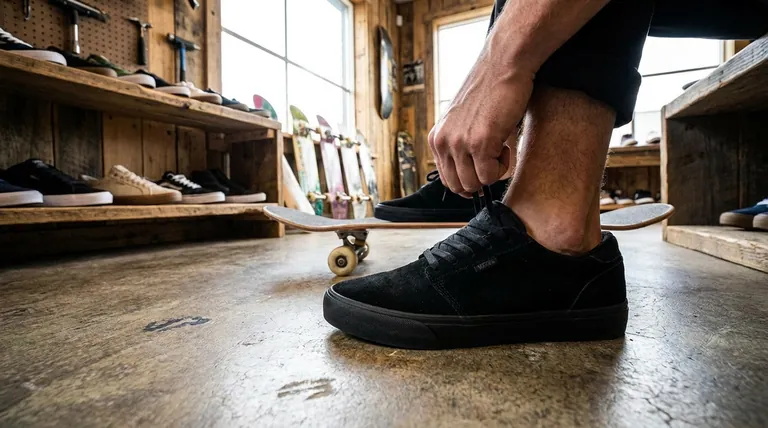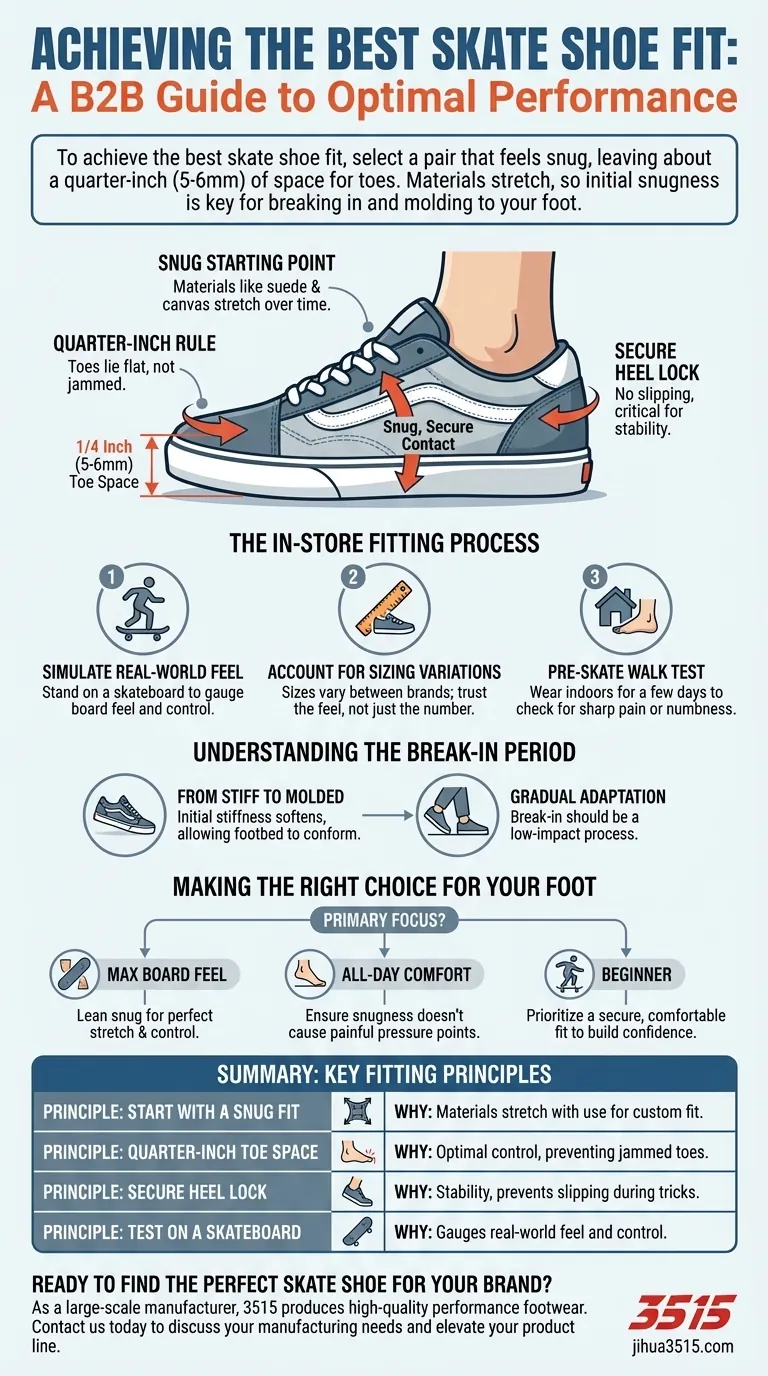To achieve the best skate shoe fit, you should select a pair that feels snug throughout the foot without being painful, leaving about a quarter-inch of space for your toes. Because materials like suede and canvas stretch, this initial snugness is crucial; the shoe will break in and mold to your foot for optimal board control and long-term comfort.
The core principle of skate shoe fitting is to find a balance between immediate, secure contact for board feel and the anticipated stretch of the materials. A shoe that is slightly too tight initially is often better than one that is slightly too loose.

The Anatomy of a Proper Skate Fit
A perfect fit is less about a specific number on the box and more about how the shoe interacts with your foot. The goal is a secure connection that feels like an extension of your body, not a separate piece of equipment.
Why "Snug" is the Correct Starting Point
Skate shoes are typically made from suede, leather, or canvas, all of which have a natural tendency to stretch and break in with use. A shoe that feels perfectly comfortable and roomy right out of the box will likely become too loose after a few sessions. This looseness reduces board feel and control, increasing the risk of rolling an ankle.
The Quarter-Inch Rule for Toes
Unlike running shoes where a "thumb's width" of space is recommended, skate shoes require a much closer fit. You should aim for about a quarter-inch (about 5-6mm) of space between your longest toe and the end of the shoe. Your toes should be able to lie flat but shouldn't be jammed against the front.
Securing the Heel is Non-Negotiable
Pay close attention to heel lock. When you walk, your heel should not slip or lift out of the back of the shoe. A secure heel is critical for stability and for executing tricks properly. If your heel moves, the shoe is too big or the shape isn't right for your foot.
The In-Store Fitting Process
Trying shoes on in person is the most reliable way to ensure a good fit, as sizing can vary significantly between brands.
Simulate the Real-World Feel
If possible, stand on a skateboard in the store while wearing the shoes. This is the ultimate test. It allows you to feel how the sole interacts with the board's concave and gauge your sense of control.
Account for Sizing Variations
Never assume your size in one brand will translate to another. A size 10 in one company might fit like a 9.5 or 10.5 in another. Always try the shoe on and trust the feel over the number.
Understanding the Break-In Period
The initial fit is not the final fit. Knowing how to manage the break-in period is key to avoiding the mistake of buying a shoe that's too big.
From Stiff to Molded
New skate shoes are intentionally a bit stiff. The first few days of wear are designed to soften the materials and allow the footbed to conform to the unique shape of your foot.
The Pre-Skate Walk Test
Before ever letting your new shoes touch griptape, wear them around the house for a few days. This serves two purposes. It begins the break-in process in a low-impact way and acts as a final check. If the shoes are genuinely painful or cause numbness after just walking, they are likely the wrong size or shape for your foot. A little discomfort from stiffness is normal; sharp pain is not.
Making the Right Choice for Your Foot
Your ideal fit depends on balancing performance needs with personal comfort.
- If your primary focus is maximum board feel and performance: Lean towards the snugger side of the fit, trusting that the shoe will stretch perfectly to your foot.
- If your primary focus is all-day comfort or you have wider feet: Pay extra attention to ensure the snugness doesn't create painful pressure points, especially on the sides of your feet.
- If you are a beginner: Prioritize a secure, comfortable fit that doesn't cause pain, as this will help you stay on your board longer and build confidence.
Ultimately, a properly fitted skate shoe gives you the control you need without distracting you with discomfort.
Summary Table:
| Key Fitting Principle | Why It Matters |
|---|---|
| Start with a Snug Fit | Materials like suede and canvas will stretch with use. |
| Quarter-Inch Toe Space | Ensures toes lie flat without being jammed for optimal control. |
| Secure Heel Lock | Prevents slippage, critical for stability and executing tricks. |
| Test on a Skateboard | Simulates real-world feel to gauge board control before buying. |
Ready to find the perfect skate shoe for your brand or store?
As a large-scale manufacturer, 3515 produces a comprehensive range of performance footwear for distributors, brand owners, and bulk clients. Our production capabilities encompass all types of skate shoes and boots, ensuring you get high-quality, durable options that meet the precise fitting needs of your customers.
Contact us today to discuss your manufacturing needs and elevate your product line.
Visual Guide

Related Products
- Wholesale Breathable Training Shoes Custom Athletic Footwear Manufacturer
- Lightweight Breathable Training Shoes for Wholesale & Custom OEM Manufacturing
- Wholesale Training Shoes with Dial Lacing System Custom OEM Manufacturing
- Wholesale Breathable & Cushioned Training Shoes Custom Factory Production
- Wholesale Durable & Breathable Training Shoes for Custom Brands
People Also Ask
- What are the characteristics of canvas as a shoe material? A Guide to Lightweight, Breathable Footwear
- What are the benefits of breathable mesh in shoe design? Enhance Comfort and Performance
- What materials are best for athletic activities in warm climates? Stay Cool with Moisture-Wicking Fabrics
- Does more ground contact area mean better support? Unlock the Secrets of Stable Footwear
- What should be considered when choosing smart trainers for business casual? A Guide to Professional Style



















